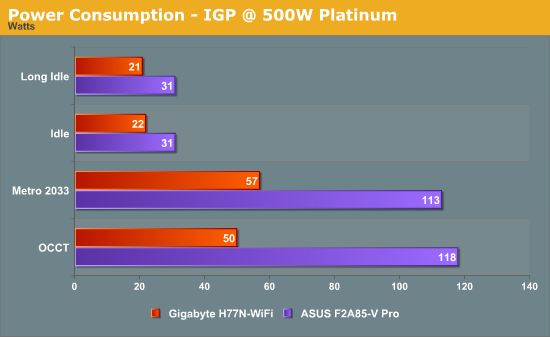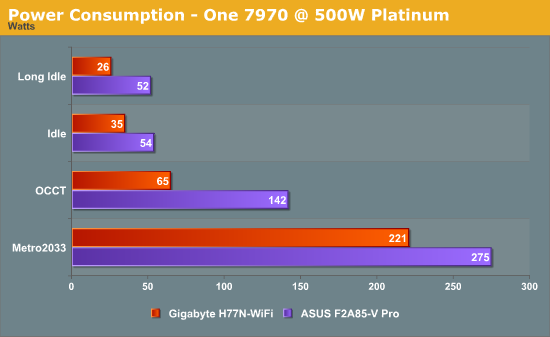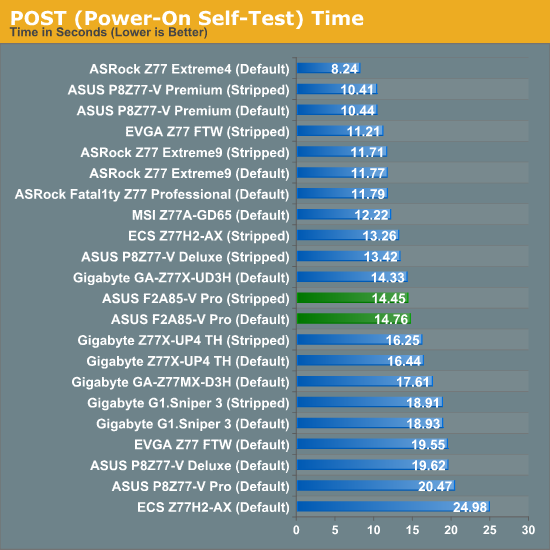ASUS F2A85-V Pro Review: A Look at FM2 with A85X
by Ian Cutress on October 10, 2012 11:20 AM EST- Posted in
- Motherboards
- Asus
- Trinity
- FM2
- A85X
Many thanks to...
We must thank the following companies for kindly donating hardware for our test bed:
OCZ for donating the Power Supply and USB testing SSD
Micron for donating our SATA testing SSD
G.Skill for donating our memory kits
ASUS for donating AMD GPUs and some IO testing kit
ECS for donating NVIDIA GPUs
Gigabyte for donating the i3-3225 used for comparison
Comparison of AMD Processors
On the following benchmarks, we will use results from comparible tests with previous processor families over the past 18 months. For AMD, this means we can compare the new Piledriver modules to Llano with its Stars cores, Phenom II and Thuban, and Zambezi with Bulldozer. The following processors are ones we have a variety of results for:
A6-3650 (32nm, 2.6 GHz) – Llano, 4 Stars cores
A8-3850 (32nm, 2.9 GHz) – Llano, 4 Stars cores
X6 1100T (45nm, 3.7 GHz Turbo) – Phenom II, 6 Thuban cores
FX-8150 (32nm, 4.2 GHz Turbo) – Zambezi, 4 Bulldozer modules
A10-5800K (32nm, 4.2GHz) – Trinity, 2 Piledriver modules
On the Intel side, we have the following:
Core i7-3960X (32nm, 3.9 GHz Turbo) – Sandy Bridge-E, 6 cores / 12 threads
Core i7-3770K (22nm, 3.9 GHz Turbo) – Ivy Bridge, 4 cores / 8 threads
Core i5-2500K (32nm, 3.7 GHz Turbo) – Sandy bridge, 4 cores / 4 threads
Core i3-3225 (22nm, 3.3 GHz) – Ivy Bridge, 2 cores / 4 threads
The aim of AMD is to put the A10 square on the bow of the Core i3-3225. For comparison, the A10-5800K release price is $122, whereas the boxed version of the i3-3225 should be ~$144.
Test Setup
| Processor |
AMD Trinity A10-4800K APU 2 Modules, 4 Threads, 3.8 GHz (4.2 GHz Turbo) |
| Motherboards | ASUS F2A85-V Pro |
| Cooling | beQuiet DarkPro CPU Cooler |
| Power Supply |
OCZ 1250W Gold ZX Series Rosewill SilentNight 500W Platinum PSU |
| Memory | G.Skill TridentX 4x4 GB DDR3-2400 10-12-12 Kit |
| Memory Settings | XMP |
| Video Cards |
ASUS HD7970 3GB ECS GTX 580 1536MB |
| Video Drivers |
Catalyst 12.3 NVIDIA Drivers 296.10 WHQL |
| Hard Drive | Corsair Force GT 60 GB (CSSD-F60GBGT-BK) |
| Optical Drive | LG GH22NS50 |
| Case | Open Test Bed - DimasTech V2.5 Easy |
| Operating System | Windows 7 64-bit |
| SATA Testing | Micron RealSSD C300 256GB |
| USB 2/3 Testing | OCZ Vertex 3 240GB with SATA->USB Adaptor |
Our main Intel comparison system is a to-be-reviewed Gigabyte H77N-WiFi with a 65W dual core i3-3225 processor against the 100W A10-5800K.
Power Consumption
Power consumption was tested on the system as a whole with a wall meter connected to a Rosewill 500W 80PLUS Platinum SilentNight power supply. As I am in the UK on a 230-240 V supply this leads to ~75% efficiency at low loads, and 90%+ efficiency between 20% and 100% loading. This method of power reading allows us to compare the power management of the UEFI and the board to supply components with power under load, and includes typical PSU losses due to efficiency. These are the real world values that consumers may expect from a typical system (minus the monitor) using this motherboard.


From our internal results, testing with 1 GPU on the 500W Platinum and 1250W Gold gave similar power readouts (Idle/OCCT/Metro on 500W gave 54/142/275, on 1250W gave 59/148/280), which means the 1250W is still good for comparison on the system. However for IGP testing, it was important to use the 500W. Our main comparison is the i3-3225 dual core Intel system on the to-be-reviewed Gigabyte H77N-WiFi, though the wattage between the processors accounts for large differences under load. At idle the larger ATX F2A85-V Pro does consume more power – if we get an ITX FM2 system, this will be a better comparison to test.
POST Time
Different motherboards have different POST sequences before an operating system is initialized. A lot of this is dependent on the board itself, and POST boot time is determined by the controllers on board (and the sequence of how those extras are organized). As part of our testing, we are now going to look at the POST Boot Time - this is the time from pressing the ON button on the computer to when Windows starts loading. (We discount Windows loading as it is highly variable given Windows specific features.) These results are subject to human error, so please allow +/- 1 second in these results.

The F2A85-V Pro uses ASUS’ new CAP BIOS system, designed to aid in POST times across their motherboard range. It helps a little here, as normally for ATX boards POST times are in the 16+ second region – the CAP BIOS reduces this to just under 15 seconds.










66 Comments
View All Comments
cjs150 - Friday, October 12, 2012 - link
Except for the complete power users I am not sure full ATX makes sense for the vast majority of people no matter what CPU you use.mAtx has room for 4 PCI-E/PCI slots. even if the GPU takes up 2 slots what do people use the rest for? Sound card, TV tuner then what? [If any one says RAID card - why do you need a discrete GPU for what is effectively a NAS]
Having just built an HTPC using a mini-ITX board it is remarkable what power you can have on tap with just one PCI-E slot
groundhogdaze - Saturday, October 13, 2012 - link
Yea, full ATX is making less and less sense these days. My main system is full sized but most of the systems I own are ITX or smaller. I just slapped together a HTPC using a Cooler Elite120 ITX case, an old GTX-560ti video card,16gb of RAM and an i3-2100 CPU so it double duties as a Home Gaming Theater as well. It is awesome how much power one can squeeze into a small system these days.vkristof - Saturday, October 13, 2012 - link
I'd have some interest in the AMD combo if it could drive 3 displays.If it can, what are the limitations?
Teknobug - Monday, October 15, 2012 - link
Looks like I'm going with the i5 3570K and P8Z77 board combo this time around and I've been a long time AMD user since the late 90's, I was highly interested in the A10 5800K but the benchmarks look ridiculous, especially the gaming benchmarks.Shadowmaster625 - Monday, October 15, 2012 - link
"On AMD the results are better, making the GPU the limiting factor." Please find this sentence in your article and review it for possible errors. After all, how can anything be better on AMD? lol. Seriously I think you meant intel.markcomp - Sunday, March 24, 2013 - link
OK, a lot of this is right on the edge of my understanding, and as I was about to put together another PC for my kids, the intro on board specs, chipset etc has just got me a bit confused.I was not looking at a Trinity as the budget won't stretch that far, but had come up with the following (actually the boys 13 and 15 did most of the research):
Will they work well together, and is there a better combination for the price (or less).
Sadly over here in The UK, we can’t get the deals like you folks across the big pond and this lot comes to £450 ($685):
Processor £100
Mobo and graphics card £150 each approximately
AMD Piledriver FX-6 Six Core 6300 Black Edition 3.50GHz (Socket AM3+) Processor
Asus Sabertooth 990FX AMD 990FX (Socket AM3+) DDR3 Motherboard
(how is this different from the R2.0 version)
One of the following:
Sapphire HD 7850 2048MB GDDR5 PCI-Express Graphics Card
Sapphire HD 7850 OC Edition 2GB Dual DVI HDMI DisplayPort PCI-E Graphics Card
Asus HD 7850 DirectCU II V2 2048MB GDDR5 PCI-Express Graphics Card
In retrospect, this should perhaps be a forum post, but having got this far....
Thanks anyway - what a good site, glad I found it